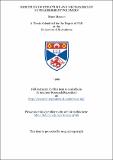NMR study of structure and mechanisms of superabsorbent polymers
Abstract
Commercially important superabsorbent polymers are crosslinked polymers of partially neutralised acrylic acid which can typically absorb and retain up to a hundred times their own weight in water. Superabsorbent polymers are most widely used in the personal hygiene industry where they are found in the core of disposable nappies, external feminine sanitary products and adult incontinence pads as absorbents for bodily fluids. Many other applications have been found through their amazing absorptive properties including artificial snow, artificial muscles and the prevention of water leakage into underground transmission cables. Superabsorbent polymers have many important industrial uses although little investigation into their structure and mechanisms has been done to date. As a result of superabsorbent polymers being totally insoluble in all NMR solvents solid state ¹³C CP/MAS NMR was used to investigate various structural aspects of the polymer in both dry and hydrated states. The NMR work carried out on the structure of the superabsorbent polymers suggests differences in structure between polymers neutralised before and after polymerisation takes place. It also suggests different tacticity within the polymer, seen as the polymer becomes more hydrated. ²³Na relaxational studies have given an insight into the change in the sodium ion environment as the polymer becomes more hydrated. The effect of increasing neutralisation of the polymer was also investigated. Nuclear Magnetic resonance imaging was also used to try and investigate the mechanism of absorption of liquid by the polymer. From the images produced it was seen that the liquid is not absorbed homogeneously throughout the polymer sample and a more intense region is seen at the front of the image suggesting a solvent front. Commercial superabsorbent polymers are usually coated to enhance their absorptive properties. Experiments were carried out using a sodium ion-selective electrode to try and determine whether or not this coating provided the polymer with an osmotic ion-exclusion membrane. The sodium ion-selective electrode allowed differences in [Na⁺] before and after the addition of polymer to a solution of NaCl to be detected, and consequently allowed the presence of an osmotic ion-exclusion membrane to be determined.
Type
Thesis, PhD Doctor of Philosophy
Collections
Items in the St Andrews Research Repository are protected by copyright, with all rights reserved, unless otherwise indicated.

